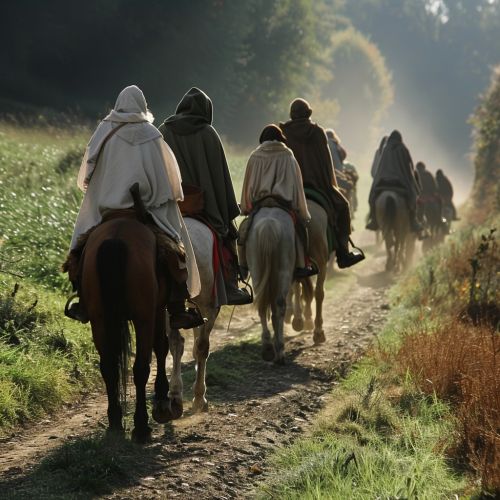The Canterbury Tales
Introduction
The Canterbury Tales is a collection of 24 stories written by Geoffrey Chaucer between 1387 and 1400. The tales are presented as part of a storytelling contest by a group of pilgrims as they travel together on a journey from London to the shrine of Saint Thomas Becket at Canterbury Cathedral. The text is a cornerstone of English literature and provides a vivid portrayal of medieval society.


Structure and Form
The Canterbury Tales is structured as a frame narrative, a literary technique that involves a story within a story. The overarching frame is the pilgrimage, while the individual tales are the stories told by the pilgrims. Chaucer employs a variety of literary forms within the tales, including fabliau, romance, exemplum, and sermon.
The General Prologue
The General Prologue introduces the reader to the 29 pilgrims, each of whom represents a different segment of society. Chaucer provides detailed descriptions of each character, offering insights into their personalities, social status, and moral values. The Prologue sets the stage for the tales that follow and establishes the social dynamics among the pilgrims.
Themes and Motifs
The Canterbury Tales explores a wide range of themes, including social class, corruption within the Church, and the complexities of human nature. Chaucer uses satire and irony to critique the social and religious institutions of his time.
Social Class
The tales reflect the rigid class structure of medieval society. Characters from different social backgrounds, such as the Knight, the Miller, and the Wife of Bath, offer perspectives that highlight the tensions and interactions between various classes.
Corruption in the Church
Several tales, such as the Pardoner's Tale and the Summoner's Tale, focus on the corruption and hypocrisy within the Church. Chaucer criticizes the moral failings of religious figures, who often exploit their positions for personal gain.
Human Nature
Chaucer delves into the complexities of human nature, exploring themes of love, greed, jealousy, and redemption. The tales often feature characters who are flawed and multifaceted, providing a nuanced portrayal of humanity.
Literary Techniques
Chaucer employs a range of literary techniques to enhance the narrative and engage the reader. His use of vernacular English, rather than Latin or French, was revolutionary and helped to establish English as a legitimate literary language.
Satire and Irony
Satire and irony are prevalent throughout The Canterbury Tales. Chaucer uses these techniques to critique social norms and institutions, often highlighting the gap between appearance and reality.
Characterization
Chaucer's skillful characterization brings the pilgrims to life. Each character is vividly described, with unique traits and behaviors that make them memorable. The detailed portraits in the General Prologue serve as a foundation for understanding the tales they tell.
Symbolism
Symbolism is used to add depth and meaning to the tales. For example, the pilgrimage itself can be seen as a symbol of the journey of life, with each tale representing different aspects of the human experience.
Influence and Legacy
The Canterbury Tales has had a profound impact on English literature and culture. It has been studied, adapted, and referenced in various forms over the centuries.
Literary Influence
The work has influenced countless writers and poets, including William Shakespeare, John Milton, and T.S. Eliot. Its innovative use of the English language and diverse narrative forms set a precedent for future literary works.
Cultural Impact
The Canterbury Tales has permeated popular culture, inspiring adaptations in film, theater, and television. Its themes and characters continue to resonate with contemporary audiences, reflecting the timeless nature of Chaucer's insights into human behavior.
Manuscripts and Editions
Numerous manuscripts of The Canterbury Tales exist, each with variations in text and order. The most famous manuscript is the Ellesmere Manuscript, which is richly illuminated and provides valuable insights into the text's early reception.
Early Printed Editions
The first printed edition of The Canterbury Tales was produced by William Caxton in 1476. Subsequent editions by Richard Pynson and Wynkyn de Worde helped to establish the text's popularity and accessibility.
Modern Editions
Modern editions of The Canterbury Tales often include extensive annotations and glossaries to aid readers in understanding the Middle English text. Scholarly editions provide critical analysis and contextual information, enhancing the reader's appreciation of Chaucer's work.
